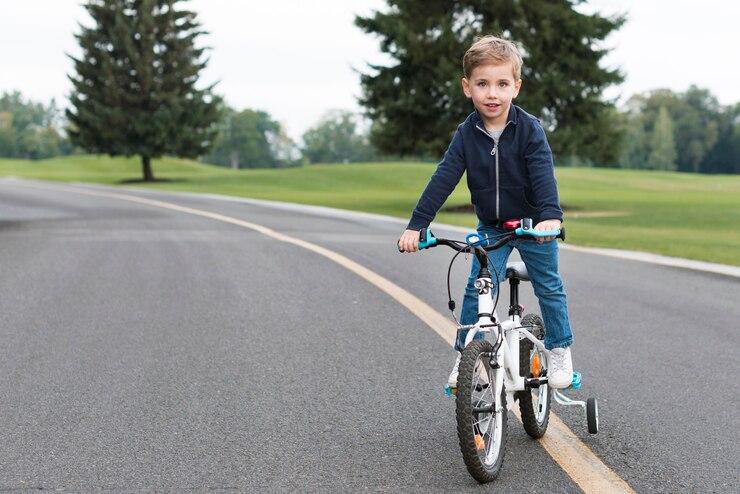A right-sized bike plays a significant role in helping kids build their cycling skills and making them genuinely enjoy the ride. It is, therefore, important to know the difference between kids bikes and adults bikes. But how to measure bike size for kid?
Both are sized differently — kids bikes are rather measured by wheel size than frame measurement. An over or under-sized cycle makes cycling a horrible experience for any kid.
Brands quote age ranges for bicycle sizes but, due to children’s growth at different rates, it’s not the best way to make sure a bike will fit comfortably. This guide will help you to find the perfect fit for your little one.
Kids Bike Size Chart
The following chart consists of different wheel measurements according to the age, inseam, and height range of kids. Use this chart to get a general idea of which size your child needs, but don’t skip the steps below!
| Wheel Size | Age | Inseam | Height |
| 12″ | 2 – 3 years | 15″ – 18″ | 36″ – 39″ |
| 14″ | 2 – 4 years | 15″ – 20″ | 37″ – 44″ |
| 16″ | 4 – 6 years | 16″ – 22″ | 41″ – 48″ |
| 20″ | 5 – 8 years | 19″ – 25″ | 45″ – 54″ |
| 24″ | 8 – 11 years | 23″ – 28″ | 49″ – 59″ |
| 26″ | 10 + years | 25″ + | 56″ + |
Measuring Your Child
Measuring your child is an important step in choosing the right size.
- Use a measuring tape to measure your child.
- Start with measuring their inseam, which is the inside leg measurement.
- Then measure their height.
- Most children’s cycles are sized by wheel dimension, so tally the measurement chart and select the most appropriate size that will be the best fit.
How To Measure Inseam For Bike?
When considering buying a bike online, this measurement is quite helpful. When purchasing a bicycle for your child without actually seeing it, it is the best source of information.

Make your child stand barefoot against a wall. Between their legs, firmly place a book against the pelvic bone. Next, determine how high the book’s top edge is above the ground.
Inches or centimeters should be used to record the measurement. Use the sizing table above to choose the correct wheel size for your measurements when buying a cycle.
A good fit improves control, lowers the chance of injury, and guarantees an enjoyable riding experience.
How To Measure Bike Wheel Size?
Wheel size is the diameter of the bike’s wheel. To measure the diameter, hold the end of the measuring tape against the center of the bicycle wheel.

Then extend the tape in a straight line to the outer edge of the tire. For traditional sizing, double the inches to find the bicycle tire diameter.
Another easy method to find out wheel measurement is to check out the printed sizing, if visible, on the tire sidewall. Accurate wheel dimension for your kid ensures compatibility with the bike’s frame and guarantees smooth handling.
How Should a Kid’s Bike Fit?
For a child to ride safely and comfortably, their bike must fit them properly. Finding the appropriate size for a child involves taking into consideration various elements including bike height, inseam, pedals, weight, and handlebars.

Parents can give their children a cycle that encourages a safe and fun riding experience by taking these factors into account.
Here are the five most important factors to consider when looking for a perfect-fit bicycle for your child:
Handlebar
To provide a comfortable riding position, the handlebars should be at the proper height and away from the child’s body. They should allow the child to keep a loose grip and have easy access to the gearshift and brakes.
The benefits of having adjustable handlebars are that they enable adjustments to adapt to the child’s growth and the changes in their riding preferences.
Bike Weight
Young riders need a lightweight bike because it improves control and maneuverability. Avoid buying your kid a bicycle that is too heavy or uncomfortable for them to handle or carry.

Lightweight components like aluminum are preferred for children’s cycles, they reduce total weight while maintaining durability.
Pedals
Select pedals that are easy for kids to pedal on and are the right size for their feet. While riding, the chance of their feet slipping is decreased by non-slip or textured pedals, which provide better grip. Reflector-equipped pedals improve visibility and safety, especially in low light.
Height
To ensure a balanced and stable ride, the bike’s dimensions should be appropriate for the child’s height. Both feet should be comfortably positioned on the ground while they are seated on the bicycle so that they can maintain control. A child should confidently stop and start without fumbling with the right fit.
Inseam
The bike’s standover height, or the distance between the ground and the top tube of the frame, is determined by the measurement of the inseam. The child should ride the bicycle while keeping both feet flat on the ground at a safe standover height.

To prevent injuries and ensure easy mounting and dismounting, maintain a proper standover clearance. Proper fit is important for a kid’s positive and joyful cycling experience.
Types of Bikes For Kids
These are the five types of kids cycles:
Balance Bikes (2 to 4 y/o)
Perfect for toddlers learning to balance and steer without pedals. Assisting in the development of coordination and self-assurance before switching to pedal cycles.
Small Wheelers (3 to 5 y/o)
They have tiny wheels and training wheels on both sides for increased stability. Appropriate for young children who are beginning to pedal and are gaining expertise.
Middle Wheelers (4 to 6 y/o)
Are slightly bigger bicycles for growing children. Kids are often motivated to ride without training wheels to further develop their balance.
20-Inch Wheel Bikes (5 to 9 y/o)
Offered in different varieties, such as BMX and mountain cycles. Ideal for kids who are ready to ride on more challenging terrain after gaining experience from smaller cycles.
24-Inch Wheel Bikes (7+ y/o)
Older children and young teens should use bigger bikes. They have better performance and adaptability for riding on any kind of terrain.
What To Do When Your Child is in Between Sizes?
Apart from knowing how to measure bike size for kids, there is another problem that you may face when buying a bicycle. It’s pretty easy to choose a cycle when your child fits nicely in between the recommended height and inseam measurements in the measurement chart.

However, it’s tougher when your kid is at the upper end of the suggested height and inseam for a bike. When this happens, parents become worried that the bicycle won’t last very long and that their child will outgrow it quickly.
If the child is pretty close to the next size, parents should go ahead and size up. This option is only valid if your child already knows how to pedal and is a confident rider.
Sometimes that’s not optimal if you are teaching your child to ride for the first time. On the other hand, if they’re not able to ride the bike comfortably and put a foot down easily, they may feel nervous, lose confidence, and be discouraged from riding.
It’s also easier for a child to overbalance and have a fall if the bicycle is too large for them. In this scenario, parents must choose the smaller one, even if their child will outgrow it soon.
A used bike could be the best way to save a few bucks, as after some months of using the bike, due to the kid’s growth, they would be ready for the next measurement.
Additionally, when a kid outgrows their existing bike, some brands provide trade-up packages with discounts on larger cycles.
Conclusion
There’s no way two kids of the same age can use the same bike. Children of the same age can be of different measurements and have a wide range of varied skills; they also grow at different rates, which makes it difficult to choose the right size.
Go through the size chart shared above before buying a bicycle for your kid. Check the cycle’s frame measurement and wheel, and tally it with your child’s inseam and height measurement to find the appropriate size.
After reading this guide, you should know how to measure bike size for kid and be able to find a ride pretty close to the ideal fit.
FAQs
Choose a bicycle with a low standover height and adjustable seat for kids beginning to ride, allowing them to comfortably touch the ground when seated.
Use inseam and height, not age, for accurate sizing. Kids grow at different rates. Size charts from bike manufacturers may provide a rough estimate.
Stabilizers boost early confidence. Remove once stable to encourage independence and minimize injury risk during the learning phase of bike riding.
Children usually start riding a bicycle between the ages of 3 and 7, but it depends on their development and confidence.



